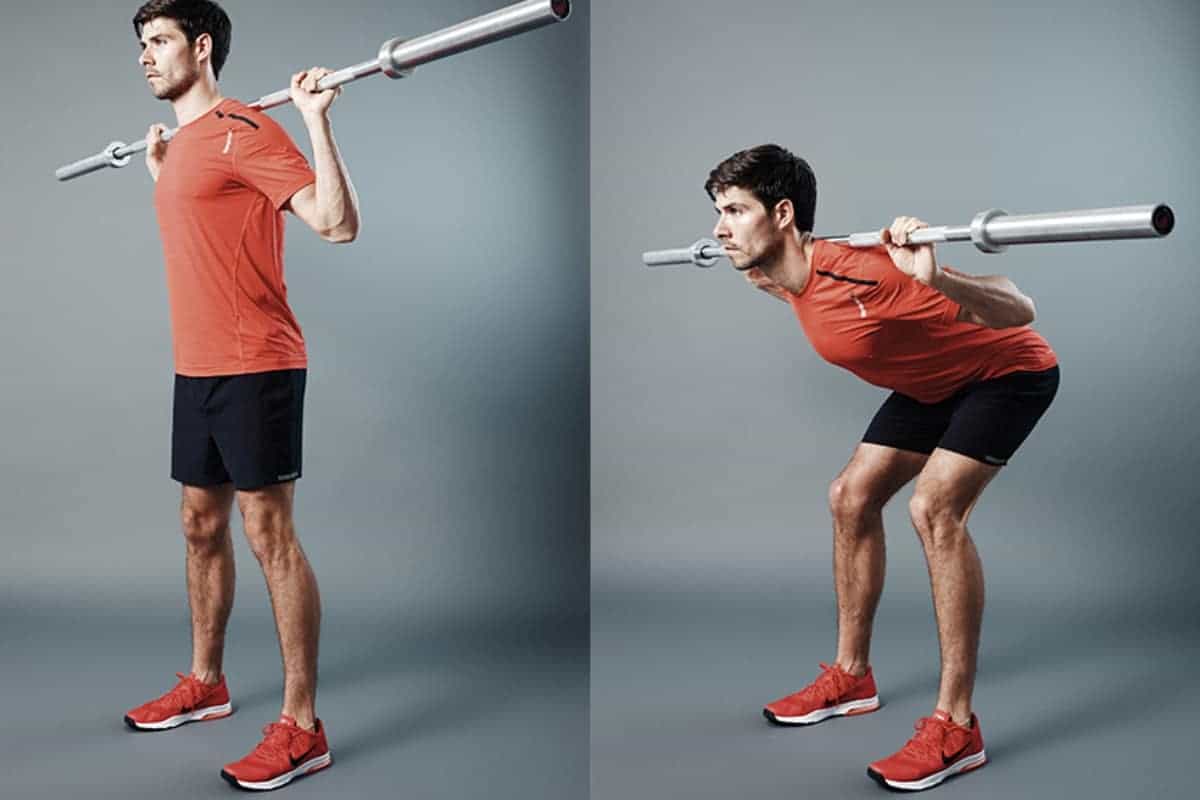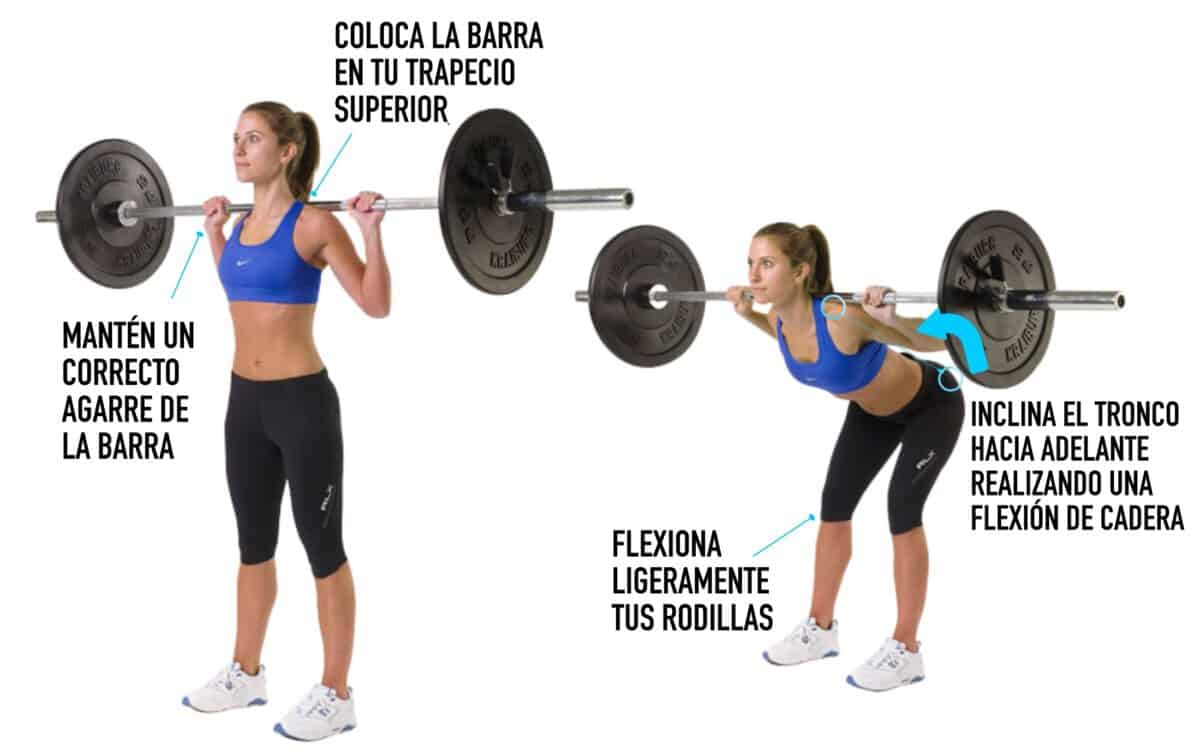In the following article, we will analyze one of the most used exercises to strengthen the muscles of the posterior chain and the spinal extensors, the good morning exercise.
What is the good morning exercise?
The good morning exercise is one of the most used exercises to strengthen the hamstrings and the spinal erectors, whose main function is hip extension and trunk extension.
The most used equipment for this exercise is the barbell, although it can also be performed without equipment or with elastic bands.
Execution of the good morning exercise
Next, we will discuss the most relevant aspects when executing this exercise.
Starting position
The performer places the barbell on the upper trapezius area and with feet shoulder-width apart.
Execution phase
The subject performs a hip flexion until the trunk is approximately parallel to the ground (eccentric phase). Then, in the concentric phase, a hip extension is performed, returning to the starting position.
Good morning exercise and eccentric work
The good morning exercise has a great load at the eccentric level, which means that during its execution, the involved musculature will present a great activation in the eccentric phase, where the performer must brake the weight of the load when performing hip flexion.
It has been shown that eccentric exercises provide great benefits reducing the risk of injury in the hamstrings (3).
Therefore, we could say that the good morning exercise is an effective exercise to prevent injuries in the hamstrings (3).
Biomechanics of the good morning exercise
The biomechanics of the good morning exercise is similar to that of the stiff-legged deadlift (3).
In both exercises, the target musculature is the hamstrings (semitendinosus, semimembranosus, and biceps femoris) that participate through an eccentric muscular action in hip flexion and through a concentric action in hip extension.
The good morning exercise is a closed kinetic chain exercise highly recommended to emphasize the work of the hamstrings. Additionally, the spinal extensor muscles (spinal erectors) also present a great activation.
McGill et al. (2009) conducted a study on the kinematics of the exercise and observed that during an execution of the good morning exercise without load, participants reached a hip flexion of 55º and a lumbar flexion of 20º, which are lower values than those obtained when performing the exercise with load.
Therefore, executing the exercise with load helps us achieve a greater ROM during the good morning exercise. In the following table, we can observe the degrees of joint flexion according to the load percentages used in the exercise.

It should be added that the muscle with the highest percentage of muscle activation was the spinal erector (thoracic region) with 17% of the maximum voluntary isometric contraction (MVIC) followed by the spinal erector (lumbar region) with 12.5% of the MVIC (3).
The percentage of muscle activation is in relation to the maximum voluntary isometric contraction (MVIC), which is obtained through a test and is related to the peak maximum force.
The biceps femoris presented a muscle activation of 5% relative to the MVIC (3).
McAllister et al. (2014) observed in their study that the muscle activation of the spinal erectors in the good morning exercise is similar to that achieved in the Romanian deadlift and the prone leg curl machine.
Effects of load in the good morning exercise
In their study, Vigotsky et al. (2015) wanted to observe how the percentage of load influences muscle activation and hamstring stretching during the exercise.
For this, several subjects performed the good morning exercise with 50%, 60%, 70%, 80%, and 90% of their 1-RM with two minutes of rest between sets.
Generally, the muscle activation of all the observed muscle groups increased as the percentage of load in the good morning exercise increased.
Except when working at 80% and 90% of 1-RM, where the spinal and thoracic erectors showed a slight decrease in their activation (3).
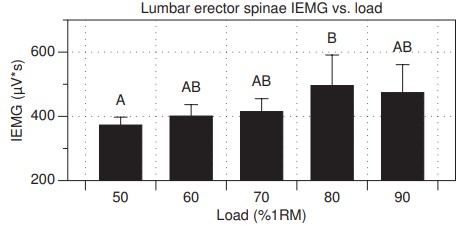
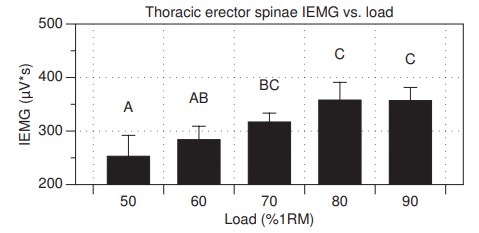
It was also seen that as the load increases, there is greater knee flexion in the good morning exercise, although the changes were not significant (3).
Unlike the spinal erectors, the lateral hamstrings had greater activation in repetitions at 90% of the 1-RM than at 80% of the 1-RM (3).
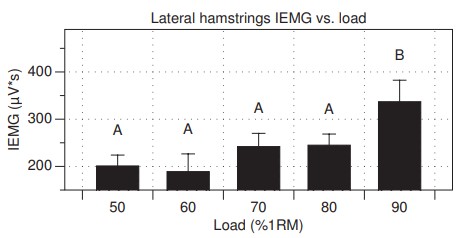
In the medial hamstrings, however, muscle activation increased progressively as the % of RM increased (3).
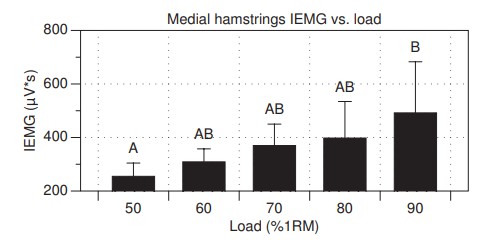
Therefore, we could say that an increase in load translates to greater muscle activation in the analyzed musculature in the good morning exercise (hamstrings and spinal erectors).
Vigotsky et al. (2015) also observed that the long head of the biceps femoris and the semitendinosus reached the highest percentages of stretching compared to the other hamstrings.
However, the stretching of these muscles decreased as the load increased (3).
Additionally, the authors saw that the stretching of the hamstrings during the good morning exercise was greater than that achieved during a sprint (3).

The spinal erectors showed the best average muscle activation during the good morning exercise.
Due to the great participation of the agonist musculature in the eccentric phase of the good morning exercise and the great stretching capacity, it becomes a very effective exercise to prevent injuries in the hamstrings (3).
Comparison of the good morning exercise with exercises with a similar motor pattern
In the study by McAllister et al. (2014), they compared the muscle activation of different muscles between the good morning exercise, the Romanian deadlift, the prone leg curl, and the glute-ham raise.
In this study, several trained subjects had to perform the mentioned exercises at 85% of their 1-RM.
Muscle activation of the biceps femoris in the eccentric phase
As we can see in the following graph, the Romanian deadlift and the good morning exercise were where the biceps femoris presented the greatest activation in the eccentric phase.
Next was the glute-ham raise, and the exercise where the biceps femoris was least activated during the eccentric phase was the prone leg curl.
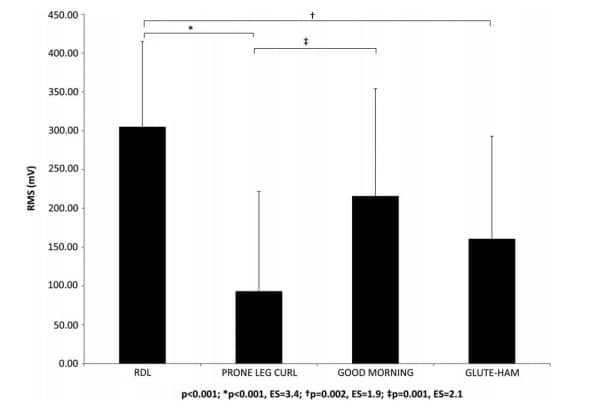
Muscle activation of the semitendinosus in the eccentric phase
In this case, it was the Romanian deadlift that presented greater muscle activation of the semitendinosus, followed by the good morning exercise, the glute-ham raise, and finally the prone leg curl (1).
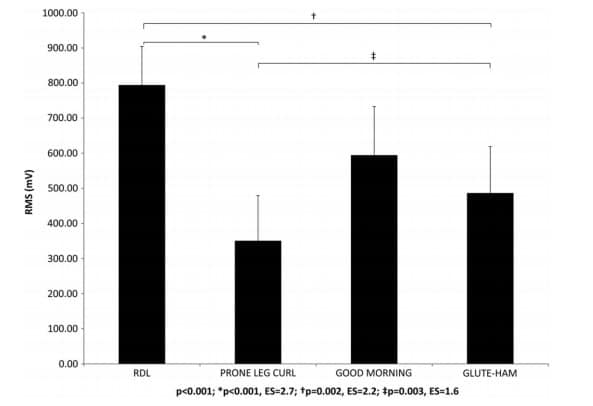
Muscle activation of the spinal erector in the concentric phase
If we analyze the muscle activation of the spinal erector in the concentric phase, the exercise in which it was most activated was the glute-ham raise, followed by the prone leg curl (1).
In the good morning exercise and the Romanian deadlift, the spinal erector was less activated during the concentric phase (1).
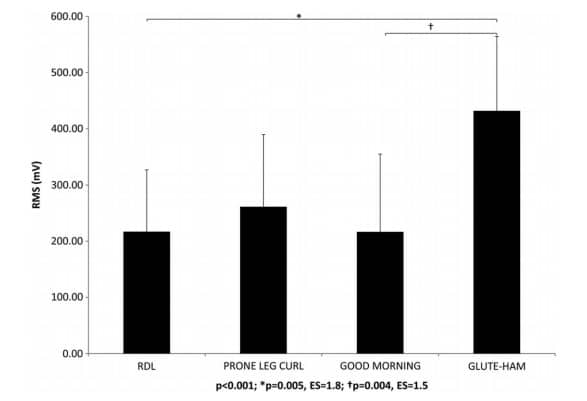
Muscle activation of the biceps femoris in the concentric phase
In the concentric phase of the glute-ham raise and the Romanian deadlift, the biceps femoris was most activated. These two exercises were followed by the good morning exercise and finally the prone leg curl (1).
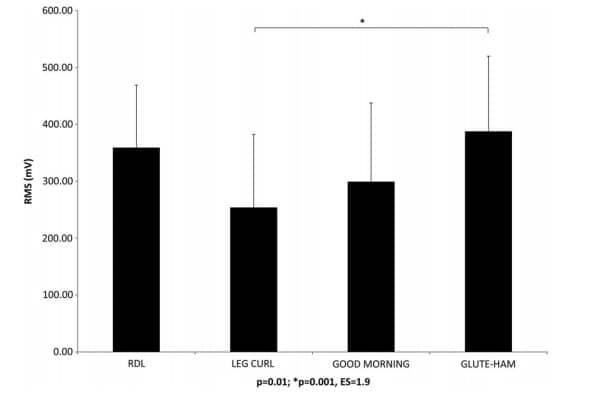
Muscle activation of the semitendinosus and semimembranosus in the concentric phase
Again, the glute-ham raise was the exercise in which in the concentric phase there was greater activation of the hamstrings, in this case of the semitendinosus and the semimembranosus (1).
The good morning exercise was the second in which this musculature was most activated, followed by the prone leg curl and finally the Romanian deadlift (1).
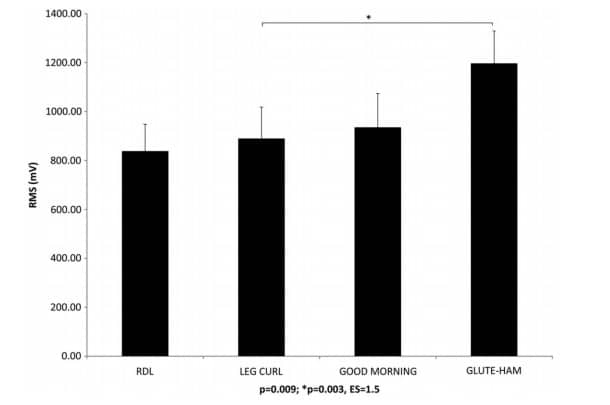
Muscle activation of the gluteus medius in the concentric phase
If we analyze the muscle activation of the gluteus medius, it was in the Romanian deadlift where it was most activated, followed by the prone leg curl and the glute-ham raise (1).
It is noteworthy that in the good morning exercise, the gluteus medius presented low values of muscle activation (1).
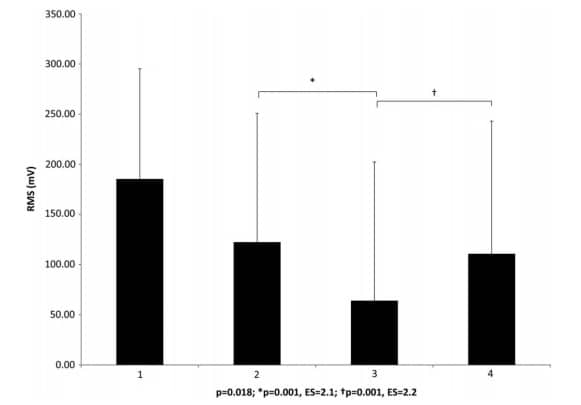
What does the good morning exercise work?
As a conclusion of the study by McAllister et al. (2014), we can say that in the good morning exercise and the Romanian deadlift, the hip and spinal extensor muscles present greater muscle activation in the eccentric phase of the movement.
Therefore, it is interesting to use these exercises if we want to emphasize the eccentric work of the hamstrings.
With this exercise a wide variety of muscles are worked, for example, glutes, lower back, and femoral, in addition to the CORE musculature and quadriceps.
Conclusions
The good morning exercise is a great alternative to work the hip extensors (hamstrings) and the spinal extensors (thoracic and lumbar spinal erectors).
Additionally, the mentioned musculature presents high levels of muscle activation in the eccentric phase of the movement. Therefore, it would be interesting to include the good morning exercise in eccentric overload programs or when we want to emphasize eccentric work.
Therefore, the fact that the hamstrings present high levels of activation in the eccentric phase makes the good morning exercise a great alternative to prevent and reduce the risk of injuries in this musculature.
Finally, performing the good morning exercise with external load will help achieve a greater range of motion (ROM) during the execution of the exercise compared to what is achieved when performed with body weight alone.
Podcast “Good Morning Exercise”: Play in new window |
Subscribe to Apple Podcasts | Spotify | Google Podcasts |
Bibliographic references
- McAllister MJ, Hammond KG, Schilling BK, Ferreria LC, Reed JP, Weiss LW. Muscle activation during various hamstring exercises. J Strength Cond Res. 2014 Jun;28(6):1573-80. doi: 10.1519/JSC.0000000000000302. PMID: 24149748.
- McGill SM, Karpowicz A, Fenwick CM, Brown SH. 2009. Exercises for the torso performed in a standing posture: spine and hip motion and motor patterns and spine load. The Journal of
Strength & Conditioning Research 23:455–464 DOI 10.1519/JSC.0b013e3181a0227e - Vigotsky et al. (2015). Effects of load on good morning kinematics and EMG activity. PeerJ 3:e708; DOI 10.7717/peerj.708
